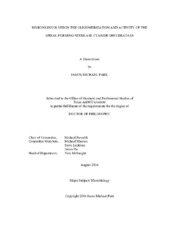| dc.description.abstract | Nitrilases offer an economic and environmentally friendly solution for the production of valuable chemicals, and the degradation of toxic industrial nitrile wastes. A lack of fine structural data has impeded rational engineering of these enzymes to expand their utility. The nitrilases form large spiral shaped oligomers, seen by electron microscopy. These spiral structures are seen in all active nitrilases, and mutations altering this structure influence activity, stability, and substrate specificity. Currently no spiral forming nitrilase has been amenable to crystallization, leaving a significant gap in
our understanding of these enzymes. Crystal structures from the larger nitrilase-superfamily
reveal a conserved dimer structure and active site.
Three regions in nitrilases are hypothesized to associate these dimer building blocks into the spiral oligomer. Two stand out as insertions relative to the crystallized homologs. These regions are hypothesized to associate the basic nitrilase dimer to form the large spiral structure. I investigate this hypothesis in the nitrilase CynD_(pum) by constructing mutations throughout these insertion regions and ascertaining their effect on enzyme activity as well as on oligomerization.
A third region that stands out from the nitrilase sequences in comparison to the crystallized superfamily members is the extension of the C-terminus. Mutations to the C-terminus in various nitrilases can alter the proteins stability, activation, and substrate specificity, but how it interacts with other regions of the protein is not understood.
In CynD, exchanging the C-terminus between the Bacillus pumilus enzyme and that of Pseudomonas stutzeri (CynD_(stut)) shows a one-way compatibility. When CynD_(pum) is paired with the P. stutzeri C-terminus (CynD_(pum-stut)), the hybrid enzyme is active and more stable than either parent enzyme. Conversely, the reverse hybrid, where the P. stutzeri CynD is paired with the B. pumilus C-terminus (CynD_(stut-pum)) is not active. In this study I exploit the stabilizing effect of the C-terminus from B. pumilus to test whether it participates in spiral formation. Additionally, I identify regions interacting with the C-terminus by looking for suppressing substitutions in CynD_(stut-pum) that restore activity. | en |


